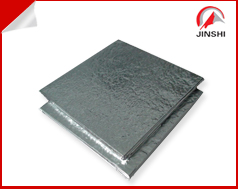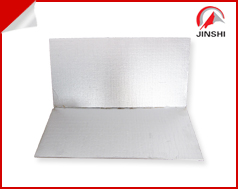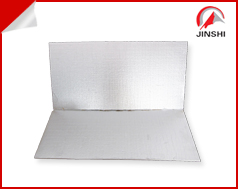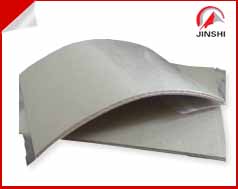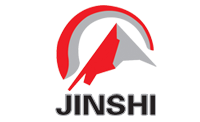Comparison of thermal insulation effect between nano - thermal insulation board and other thermal insulation materials
With the increasing scarcity of energy and rising energy prices, energy conservation and consumption reduction is imperative. Therefore, it is becoming more and more obvious to adopt low thermal conductivity refractory products in industrial furnaces and high temperature equipment. The traditional heat insulation refractory materials generally include light brick, light amorphous material, refractory fiber material, etc. because the heat insulation effect is not ideal, it can not meet the increasing heat insulation requirements. With the development of nanotechnology, high thermal insulation performance of nano-thermal insulation board came out, and has been widely used in foreign countries. In 2006, the thermal conductivity of nano thermal insulation board was developed in China, which is equivalent to that of foreign products and can be produced in batch. In this paper, we introduce the thermal insulation principle of nano thermal insulation board and compare the thermal insulation effect with other thermal insulation materials.
Thermal insulation principle of 1 nanometer thermal insulation board
Existing theories and experiments show that the thermal conductivity of the object is related to its size, for example, the thermal conductivity of SiO _ 2 solid ( Shi Ying, axial ) is 41.6 w m - 1 k - 1, the thermal conductivity of SiO _ 2 gel powder is 0.035 w m - 1 k - 1, and the thermal conductivity of SiO _ 2 aerogel is 0.014 ~ 0.016 w m - 1 k - 1; When the diameter of inorganic fiber is reduced from 15 μ m to 3 μ m, the thermal conductivity of mineral fiber cotton is reduced by 12 % and that of glass fiber cotton is reduced by 6 %.
Accord to that micro-nano scale heat transfer, when the medium scale is reduced to the micro-nano scale, the heat conductor can become a thermal insulator. That is to say, when the medium size is smaller than the average free path of the thermal carriers ( molecules, atoms, electrons, phonons, photons, etc. ), the scale effect and interface effect are obvious, the contact thermal resistance increases, the thermal conductivity decreases, and the heat transfer capability decreases. Therefore, the important difference between microscale heat transfer and macroscopic heat transfer lies in the dependence of parameters such as thermal conductivity and specific heat capacity on the scale of medium.
The main raw material for preparing the nano heat insulation board is the large-hole containing rice flour material. Due to the high porosity, the thermal conductivity is low; According to the international standard iso 2245 - 1972, the porosity of the heat-insulating product is at least 45 %, the porosity of the general heat-insulating product is 70 %, and the porosity of the large-hole containing rice flour material is 1.8 ml g - 1. So that that ultra-low heat conduction heat insulation board can be produce by accommodating the rice flour material through the large hole.
2 test
2.1 raw materials
The main raw materials for preparing nano heat insulation board are nano silicon dioxide, nano aluminum oxide, zirconium oxide and bonding agent. The chemical composition is shown in table 1.
Table 1 chemical composition and average particle size of main raw materials of nano heat insulation board
|
Raw Mateiral |
nano silicon dioxide |
nano aluminum oxide |
|
w(SiO2 )/% |
≥99.5 |
- |
|
w(Al2O3 )/% |
- |
≥ 99.0 |
|
Mean particle size/nm |
30 ±5 |
20 ±5 |
|
Specific surface area/(m2· g-1 ) |
200 ~ 300 |
50 ~ 60 |
2.2 test methods
Mixing 10 - 20 % ( mass fraction, the same below ) of nano silicon dioxide, 50 - 70 % of nano aluminum oxide, 5 - 10 % of zirconium oxide and 5 - 10 % ( added ) of bonding agent uniformly, forming a 200 mm * 25 mm sample, processing according to a certain method, and detecting the physical properties according to relevant standards.
2.3 test results
The physical and chemical properties of the nano heat insulation board are shown in table 2. The nano heat insulation board is a novel material which is formed by mixing nano powder and a special liquid bonding agent, and the thermal conductivity of the nano heat insulation board is very low and is smaller than that of static air. At high temperature, the thermal insulation effect of the nano thermal insulation board is 3 - 4 times higher than that of the traditional thermal insulation material. In order to achieve the thermal insulation effect under the same thermal conditions, the thickness of the nano thermal insulation board only needs 1 / 4 of the thickness of the ceramic fiber material.
Table 2 physical and chemical properties of nano heat insulation board
| Thermal conductivity | heating line rate of change/% | bulk density/(kg· m-3) | |
| 0 | 0.018 | 0 | |
| 200 | 0.02 | 0.2 | |
| 400 | 0.029 | 1.3 | |
| 600 | 0.032 | 2.1 | |
| 800 | 0.039 | 2.7 |
A comparison of the thermal conductivity of the nano thermal insulation panel with other thermal insulation materials is shown in fig. 1. See figure 2 for a comparison of thermal insulation effects.


Rankings of similar articles
- Advantages of using nano heat insulation board as heat insulation layer in steel ladle
- Application of nano aerogel insulation felt in agriculture facility
- Six Excellent Properties of Nano Aerogel Insulation Felt
- Application of nano heat insulation board in steel industry
- Matters needing attention in the use of nano thermal insulation board
- The nano heat insulation board greatly reduces the thickness of the heat insulation layer and provides larger space capacity for equipment
- Nano thermal insulation board, the leader of thermal insulation materials
- Nano heat insulation plate, effectively reduce heat loss
- Thermal insulation mechanism of nano thermal insulation board
- Preservation and installation method of nano heat insulation board
Latest information
- Recruitment (Domestic Sales, E-Commerce)
- Italian customers come to visit our company and reach in-depth cooperation
- JinShi participate in 2016 international wall roofing materials production and equipment Expo
- Six Excellent Properties of Nano Aerogel Insulation Felt
- Nano Aerogel Insulation Felt is known as
- Comparison of thermal insulation effect of nano aerogel thermal insulation felt and other thermal insulation materials in petroleum pipeline
- The nano aerogel thermal insulation felt has good thermal insulation performance, superhydrophobic property, long service life, compression resistance and easy installation and maintenance
- Why not many manufacturers of nano aerogel insulation felt on the market?
- Characteristics and preparation process of nano aerogel insulation felt
- Can nano heat shields be used on ships and vessels and how?
Contact us

hotline:
86-132-806-65866
The phone:86-0533-2266502
add:Shandong zibo hi-tech development zone.

